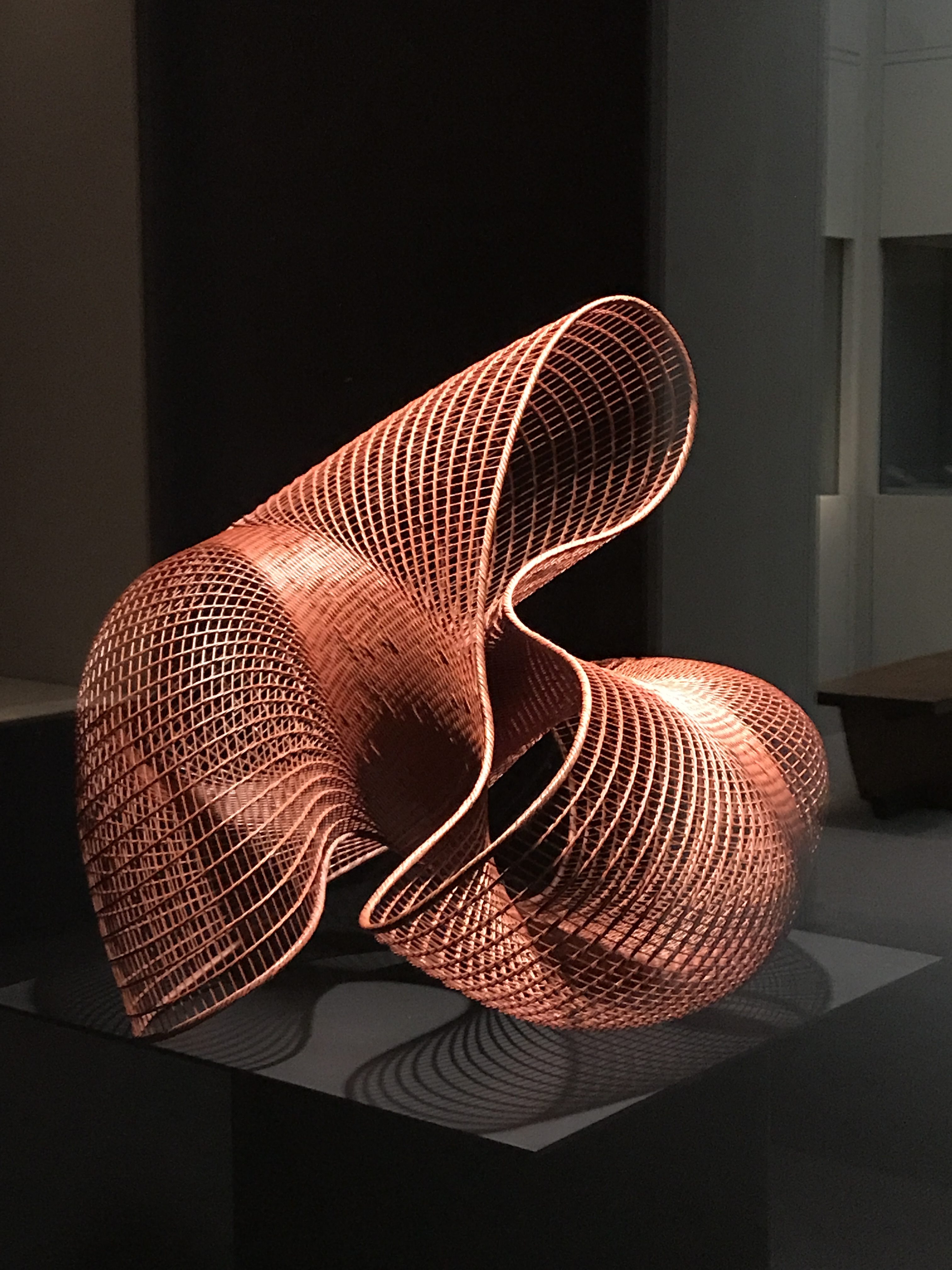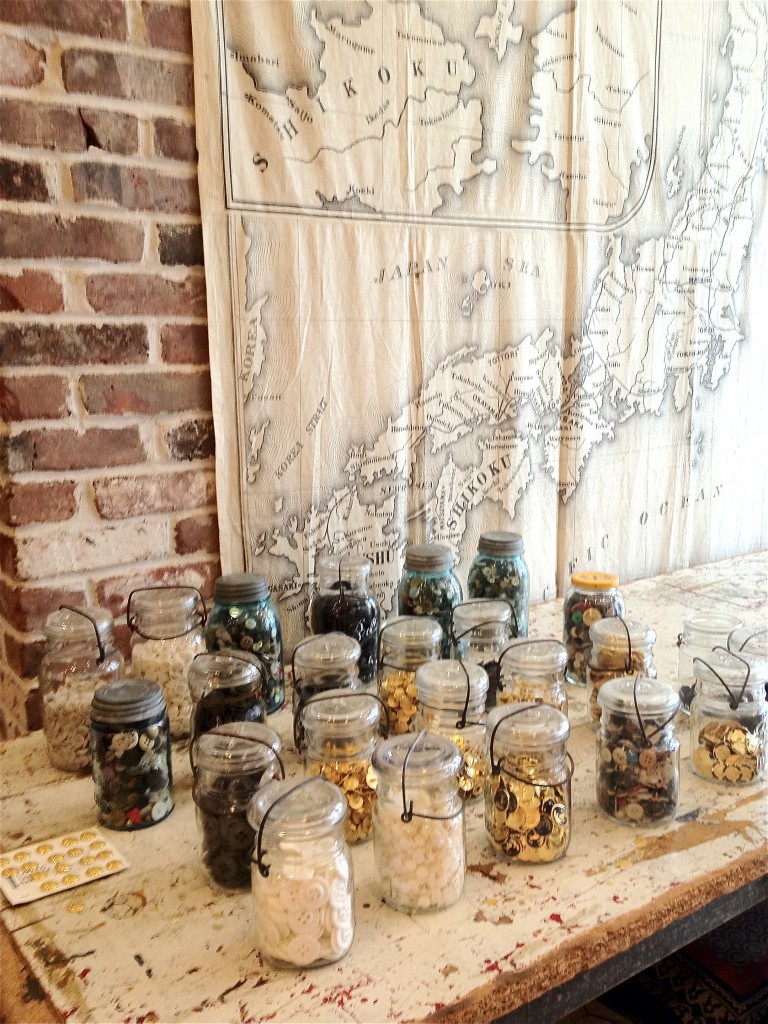On the second floor of New York’s 45 rpm, the Japanese shop known for its relaxed, fun (and expensive) natural fiber, indigo clothing, is the in-house tailor’s workstation. A roughhewn table carries a matte black sewing machine that is flanked by jars of color coded, sized buttons. 45 rpm sweaters and shirts, always marked by an “R” somewhere near an often contrasting selvedged hem, also sport a selection of buttons chosen with a seeming whimsy. I have a blue and white striped sweater hemmed in red with 5 white buttons of varying sizes. A white raw cotton shirt has twenty tiny white buttons with one, peeking out red, like a fish’s eye.
With two retail outlets in Manhattan and over 4o in Japan, 45 rpm is that rare chain store that maintains a boutique, “special find” aura. The attention to detail is stunning for a mass marketed inventory. Even if one’s purchases become more sporadic, the items themselves build into a wardrobe of ever more beautiful, well loved clothing.
 Honda Shoryu, Timber bamboo and rattan, 2000[/caption]
There is a period missing in the timeline of human development, that of the Bamboo Age. Bamboo's widespread use since earliest times - particularly in East and Southeast Asia - elevates this extraordinary plant to almost mythic status. It has been used as transport (wheeled vehicles), building material, food, weapon, musical instrument and, even, poison. For hundreds of years, simple, everyday utensils as well as refined bamboo vessels were made according to local traditions and techniques passed down from generation to generation. Most ubiquitous of all, perhaps, is the basket.
It was not until the end of the 19th century that bamboo craftsmanship began to be recognized as one of the traditional Japanese decorative arts, and, later, as an art form. As with other handmade arts in Japan, there were lineages of craftsmen who handed down techniques and developed their personal styles; Masters emerged, recognized as National Living Treasures. Six of these artists are represented in this stunning show of 90 baskets collected by Diane and Arthur Abbey since the 1990s. The show comes to a close soon at the Met Museum.
[gallery columns="2" size="full" ids="8396,8397"]
FYI: The 64th Japan Traditional Kogei - Art Crafts - Exhibition will take place at the Hiroshima Prefectural Art Museum between February 23 and March 11, 2018
"
["post_title"]=>
string(27) "Bountiful, Beautiful Bamboo"
["post_excerpt"]=>
string(0) ""
["post_status"]=>
string(7) "publish"
["comment_status"]=>
string(4) "open"
["ping_status"]=>
string(4) "open"
["post_password"]=>
string(0) ""
["post_name"]=>
string(26) "bountiful-beautiful-bamboo"
["to_ping"]=>
string(0) ""
["pinged"]=>
string(0) ""
["post_modified"]=>
string(19) "2017-09-14 10:20:27"
["post_modified_gmt"]=>
string(19) "2017-09-14 14:20:27"
["post_content_filtered"]=>
string(0) ""
["post_parent"]=>
int(0)
["guid"]=>
string(31) "http://lisalindblad.com/?p=8394"
["menu_order"]=>
int(0)
["post_type"]=>
string(4) "post"
["post_mime_type"]=>
string(0) ""
["comment_count"]=>
string(1) "0"
["filter"]=>
string(3) "raw"
}
}
Honda Shoryu, Timber bamboo and rattan, 2000[/caption]
There is a period missing in the timeline of human development, that of the Bamboo Age. Bamboo's widespread use since earliest times - particularly in East and Southeast Asia - elevates this extraordinary plant to almost mythic status. It has been used as transport (wheeled vehicles), building material, food, weapon, musical instrument and, even, poison. For hundreds of years, simple, everyday utensils as well as refined bamboo vessels were made according to local traditions and techniques passed down from generation to generation. Most ubiquitous of all, perhaps, is the basket.
It was not until the end of the 19th century that bamboo craftsmanship began to be recognized as one of the traditional Japanese decorative arts, and, later, as an art form. As with other handmade arts in Japan, there were lineages of craftsmen who handed down techniques and developed their personal styles; Masters emerged, recognized as National Living Treasures. Six of these artists are represented in this stunning show of 90 baskets collected by Diane and Arthur Abbey since the 1990s. The show comes to a close soon at the Met Museum.
[gallery columns="2" size="full" ids="8396,8397"]
FYI: The 64th Japan Traditional Kogei - Art Crafts - Exhibition will take place at the Hiroshima Prefectural Art Museum between February 23 and March 11, 2018
"
["post_title"]=>
string(27) "Bountiful, Beautiful Bamboo"
["post_excerpt"]=>
string(0) ""
["post_status"]=>
string(7) "publish"
["comment_status"]=>
string(4) "open"
["ping_status"]=>
string(4) "open"
["post_password"]=>
string(0) ""
["post_name"]=>
string(26) "bountiful-beautiful-bamboo"
["to_ping"]=>
string(0) ""
["pinged"]=>
string(0) ""
["post_modified"]=>
string(19) "2017-09-14 10:20:27"
["post_modified_gmt"]=>
string(19) "2017-09-14 14:20:27"
["post_content_filtered"]=>
string(0) ""
["post_parent"]=>
int(0)
["guid"]=>
string(31) "http://lisalindblad.com/?p=8394"
["menu_order"]=>
int(0)
["post_type"]=>
string(4) "post"
["post_mime_type"]=>
string(0) ""
["comment_count"]=>
string(1) "0"
["filter"]=>
string(3) "raw"
}
}
